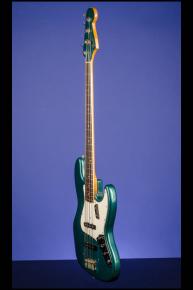A Mid-60's Custom Color Dot Neck Jazz Bass.
1966 Fender Jazz Bass.
This lightweight custom color Jazz Bass weighs just 9.30 lbs. Asymmetrical double cutaway, contoured solid alder body. One-piece maple neck with a very fast medium profile. Bound rosewood veneer fretboard with 20 original jumbo frets and inlaid pearl dot position markers. Matching Lake Placid Blue Blue headstock with transitional "Fender" in gold with black trim and five patent numbers in black below, "Jazz Bass," "Trade Mark," and "Electric Bass" in black on three lines beside, and "Offset Contour Body" at the ball end of the headstock. Single round string tree. Individual Fender tuners with oval "paddle" metal buttons. Four-bolt neck plate with the Fender backward "F" logo and the serial number "151271" above it. Two eight-polepiece, single-coil pickups with nicely balanced outputs of 6.70k and 6.76k. Three-layer white/black/white plastic pickguard with beveled edges and eleven screws. Three controls (two volume blend controls, one for each pickup, and one master tone control) and jack socket, all on metal plate adjoining pickguard. The neck is dated "7 JUL 66 A" and the potentiometers are stamped "304 6618" (Stackpole, May 1966). Black plastic knobs with white markings. Combined four-saddle bridge/tailpiece. Complete with both original bass pickup and bridge pickup covers, the bridge cover with the original (dried-out) mute. There is some minor finish checking and a few very small and insignificant indentations on the back and a small scratch (just through the finish) on the back of the bass horn. There is a tiny amount of tarnishing to the pickup covers. The Lake Placid Blue color is fresh and unfaded and there is virtually no wear to the frets. This fine example has spent most of its life in its case and is in exceptionally fine (9.00+) condition. Housed in the original Fender three-latch, rectangular black hardshell case with dark orange plush lining (9.00). Certainly the cleanest '66 LPB Jazz Bass that we have ever seen…
"After the introduction of the Jazzmaster in 1958, Fender needed an upscale model to augment the bass line. In 1960, Leo's new Jazz Bass borrowed the offset waist and part of the name from the Jazzmaster. It also featured a narrower neck width, which was faster playing than the Precision Bass" (J.W. Black and Albert Molinaro, The Fender Bass, p. 25).











